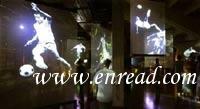| ||||||||||||||||||||||||||||||||||||||||||||||||||||||||||||||||||||||||
|
A visitor uses the interactive1 media at the soccer museum in Sao Paulo October 23, 2008. Much of the soccer museum is interactive, using latest technology to chronicle the legendary2 moments of Brazilian football. The museum also traces football's transformation3 from an elite4 sport to the passion of the masses in this vast, multiracial country of 190 million people. In Brazil, soccer is considered an art form. So it is only fitting that the sport Brazilians call "the beautiful game" gets its own museum. This is the land that produced football greats such as Garrincha, Zico, Romario, Ronaldo, Kaka, and the most famous of all, Pele. It is the only country to have qualified5 for every World Cup, and the only one to win it five times. But until now, Brazil has never had a truly national museum honoring the sport that has become synonymous with Brazilian culture. That changed last month when the Museu do Futebol, or Football Museum, opened at Pacaembu Stadium in Sao Paulo. Upon entering the museum, visitors are greeted in Portuguese6, Spanish and English by a life-size image of Pele, who is so revered7 in Brazil that he is known simply as "O Rei," or "The King." "The Louvre has the Mona Lisa. We have our own piece of art -- Pele," said Hugo Sukman of the Roberto Marinho Foundation, which helped fund the construction of the museum. In many ways, the museum is a shrine8 to Pele. One of its most impressive displays is a temporary exhibit with 140 items from Pele's personal collection, including the wooden shoeshine box he used as a boy to earn spare change and the ball from his 1,000th goal in 1969. The museum traces football's transformation from an elite sport to the passion of the masses in this vast, multiracial country of 190 million people. From the jungles of the Amazon to the slums of cities like Rio de Janeiro and Recife, soccer is a constant that unites Brazilians from all walks of life. "Inevitably9, a museum about football is also a museum about the history of Brazil and Brazilian culture," said Leonel Kaz, the museum's curator. 在巴西,足球一直被视为一门艺术。既然是门艺术,这项巴西人眼中的“美丽的运动”就应该有它自己的博物馆。 在巴西这片土地上,曾诞生了加林查、济科、罗马里奥、罗纳尔多和卡卡等众多足球巨星,还有“天王级”球星贝利。巴西是全世界唯一一个打进历届“世界杯”决赛的国家,也是唯一五次夺冠的国家。 但即便如此,巴西一直都没有为这项代表国家文化的“国宝级”运动建一个真正意义上的国家博物馆。不过这一状况在上个月终于得到了改变——巴西的“足球博物馆”在圣保罗的Pacaembu体育场落成开馆。 走进博物馆,一个“真人贝利”大小的模型用葡萄牙语、西班牙语和英语三种语言向你问好。贝利深受巴西人民尊敬,被称为“球王”。 “罗伯特·玛林赫基金会”为博物馆建设筹集资金。该基金会的雨果·萨克曼说:“罗浮宫有蒙娜丽莎,我们也有自己的艺术珍品——贝利。” 这个博物馆在很大程度上就是一个贝利纪念馆。 其中一组重头展品是贝利曾用过的140件私人物品,包括他儿时打零工用的一个木制鞋油盒以及1969年他打入的个人职业生涯中的第1000粒进球。 博物馆的展品追溯了巴西足球从贵族运动发展为深受1.9亿国民喜爱的大众体育项目的过程。从亚马逊的丛林到里约日内卢和累西腓的贫民窟,足球将这个广阔多民族国家各阶层的人凝聚在了一起。 博物馆馆长雷奥内尔•卡兹说:“一个关于足球的博物馆必然也是关于巴西历史和文化的博物馆。” 点击  收听单词发音 收听单词发音
|
||||||||||||||||||||||||||||||||||||||||||||||||||||||||||||||||||||||||
上一篇:研究:男性偏爱红衣女郎 下一篇:研究:漂亮女候选人更易赢得选票 |
||||||||||||||||||||||||||||||||||||||||||||||||||||||||||||||||||||||||
- 发表评论
-
- 最新评论 进入详细评论页>>




